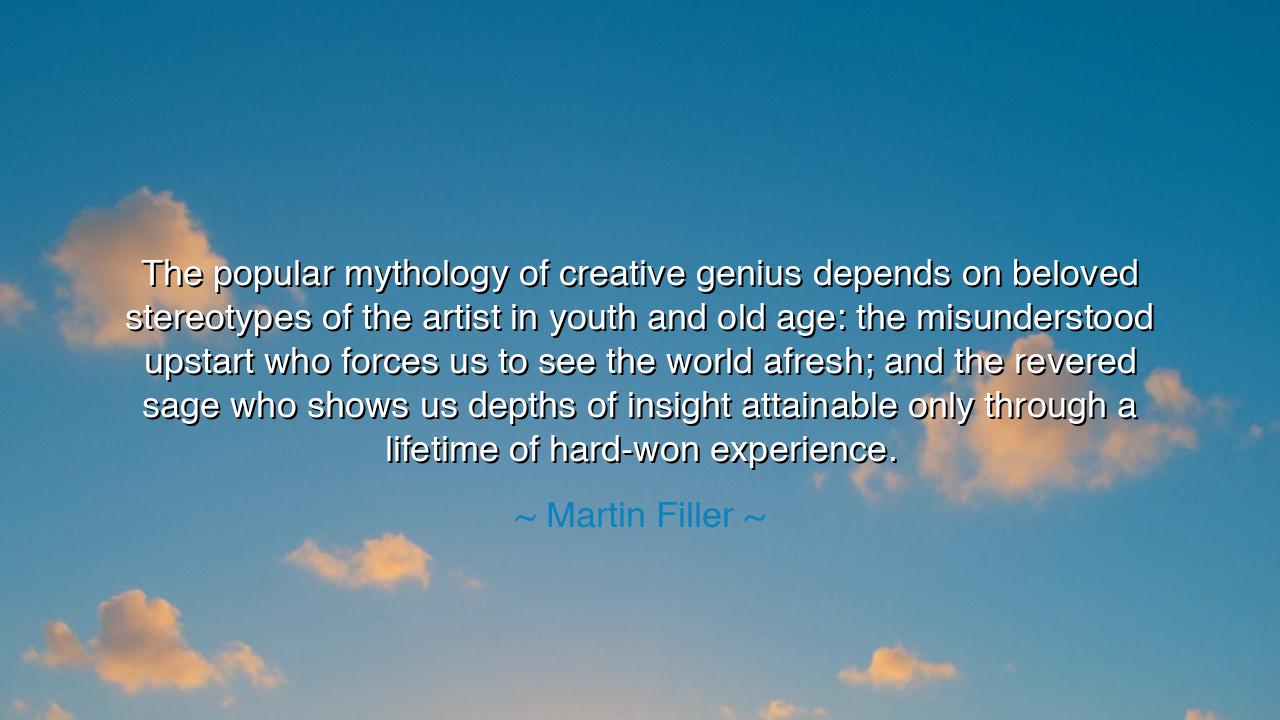
The popular mythology of creative genius depends on beloved
The popular mythology of creative genius depends on beloved stereotypes of the artist in youth and old age: the misunderstood upstart who forces us to see the world afresh; and the revered sage who shows us depths of insight attainable only through a lifetime of hard-won experience.






In the words of Martin Filler, the saying—“The popular mythology of creative genius depends on beloved stereotypes of the artist in youth and old age: the misunderstood upstart who forces us to see the world afresh; and the revered sage who shows us depths of insight attainable only through a lifetime of hard-won experience”—reveals an ancient truth about the human spirit. Across the ages, men and women have yearned to understand the mystery of creation, that divine spark which burns first as rebellion and later as wisdom. The quote tells us that society adores two forms of genius: the young visionary, aflame with discovery, and the old master, tempered by time. Between these two lies the silent desert of life’s middle years—where few listen, though much is learned.
In youth, the misunderstood upstart is like Prometheus stealing fire from the gods. The world resists him, for his eyes behold what others cannot yet see. He is mocked, doubted, sometimes cast out—but his vision endures. Think of Vincent van Gogh, whose art, filled with blazing color and trembling light, was shunned by his contemporaries. He sold but one painting in his lifetime, yet his soul set the skies ablaze with emotion. Such a one is both cursed and blessed: cursed with solitude, blessed with revelation. The young artist bears the pain of transformation, forcing the world to confront the unknown. In him, creation is a rebellion, a cry against blindness, a refusal to accept the world as it is.
But in old age, the revered sage arises—a being of quiet authority, no longer driven by the fury of youth but guided by wisdom and serenity. Like a mountain weathered by storms, he has learned that creation is not a conquest, but a communion with the eternal. Consider Leonardo da Vinci, who in his later years painted the Mona Lisa—not as a declaration of brilliance, but as a meditation on mystery itself. Every brushstroke whispers the patience of decades, the humility of one who has gazed too long into the infinite to claim mastery over it. In him, genius is no longer rebellion—it is harmony. The sage no longer fights to be seen; he teaches others to see.
Between these two archetypes—the fire of youth and the light of age—lies the truth of Filler’s words: that genius is not born, but unfolds. Society prefers extremes because they are easy to mythologize. The youth dazzles; the elder inspires. But the journey between them, the long years of toil, doubt, and self-renewal, are forgotten. Yet it is in those quiet seasons, when the world is silent and no one applauds, that the spirit of genius is tempered like steel. The myth deceives us, but the path redeems us.
We must not worship the myth alone. To do so is to forget that both the upstart and the sage are faces of the same soul. The creative spirit is eternal—it burns in the heart of every man and woman who dares to shape something out of nothing, who refuses to let the ordinary remain ordinary. Genius is not a gift of birth nor a trophy of age; it is the discipline of wonder, the courage to continue seeing the world anew even when others have ceased to look.
Let each of us, then, cultivate within our own hearts both the rebellion of youth and the wisdom of age. Be unafraid to challenge the world when it sleeps, and equally unafraid to listen when it speaks. Seek new ways to see, even when your eyes are weary. Honor your mistakes—they are your teachers. And above all, work not for glory, but for truth. For truth is the seed of all lasting creation.
In the end, the lesson is clear: the world may praise you only at your beginning or your end, but it is the sacred labor between that defines you. The artist’s path is not one of applause but of awakening. Therefore, live as both the upstart and the sage—question boldly, learn humbly, and create endlessly. In doing so, you will join the ancient lineage of those who, in youth and in age, have dared to bring light into the darkness.






AAdministratorAdministrator
Welcome, honored guests. Please leave a comment, we will respond soon